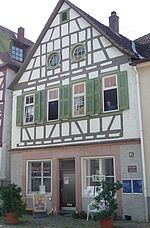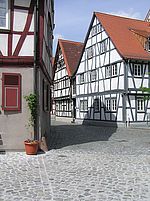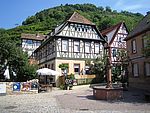The narrow alley, referred to as “Kleine Bach”, “small brook” had its first official mention in the year 1480 and it reminds of the former city brook. It used to be a very narrow alley, because the city brook used to flow there and it was dark and almost impassable. It is therefore not surprising that there are many legends and myths, such as the story of a villous goat, who used to spill the milk pots of Heppenheim’s children. House No. 3 dates back to 1791 and it was built by the Jewish community as a synagogue and back then, the Jewish school and the teacher’s flat could be found therein as well. The round window in the gable used to be decorated with a Star of David, made of coloured glass. After the new synagogue had been built at Starkenburgweg (1900 inaugurated, 1938 destroyed), the house was sold and the new owner turned it into a residential house.
The upper floor of house No. 12 was constructed around 1560. Due to the construction of an underground car park, it was transferred to a neighbouring building in 1994/95 and later, it was relocated to its original place. The museum shows pictures of the time when the house hung from the hook of a crane. House No. 14, which dates back to 1422/23, is considered the oldest conserved half-timbered building of the city. Due to the construction of the underground park for the neighbouring hotel, it was taken apart and stored for some time. In 1998/99 it was rebuilt on its original place.
Between the Kleine Bach and Siegfriedstraße, the former Sickinger Hof can be found. It is the residential building of a former house of nobility, located at the edge of the old town. Its history goes back to the 14th century. The so-called Sickinger Tor used to be the entrance gate from the old town to the courtyard.



